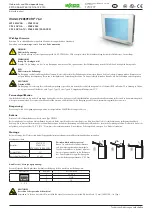
Graphic EQ, Parametric EQ, Effects, and PREMIUM RACK
143
Reference Manual
Tap Tempo pop-up window
NOTE
• If the EFFECT EDIT popup window used to set TAP TEMPO is open, this popup window is not
displayed.
• With CL V3.0 and later, the delay value (msec) is also shown in the popup window.
Effects and tempo synchronization
Some effects of the CL series can be synchronized with the tempo. There are two such types
of effect: delay-type effects and modulation-type effects. For delay-type effects, the delay time
will change according to the tempo. For modulation-type effects, the frequency of the
modulation signal will change according to the tempo.
Parameters related to tempo synchronization
The following five parameters are related to tempo synchronization.
1) SYNC 2) NOTE 3) TEMPO 4) DELAY 5) FREQ.
SYNC: ..............................This is the on/off switch for tempo synchronization.
NOTE and TEMPO: .........These are the basic parameters for tempo synchronization.
DELAY and FREQ.: ..........DELAY is the delay time, and FREQ. is the frequency of the modulation
signal. These directly affect the way in which the effect sound will
change. DELAY is relevant only for delay-type effects, and FREQ. is
relevant only for modulation-type effects.
How the parameters are related
Tempo synchronization calculates the DELAY (or FREQ.) value
*a
from the TEMPO and
NOTE.
Turn SYNC ON
Change NOTE DELAY (or FREQ.) will be set
In this case, the DELAY (or FREQ.) value is calculated as follows.
DELAY (or FREQ.) = NOTE x 4 x (60/TEMPO)
Change TEMPO DELAY (or FREQ.) will be set
In this case, the DELAY (or FREQ.) value is calculated as follows.
DELAY = NOTE x 4 x (60/TEMPO) sec
FREQ. = (TEMPO/60) / (NOTE x 4) Hz
Example 1:
When SYNC=ON, DELAY=250 ms, TEMPO=120, you change NOTE from
8th note to quarter note
DELAY= new NOTE x 4 x (60/TEMPO)
= (1/4) x 4 x (60/120)
= 0.5 (sec)
= 500 ms
Thus, the DELAY will change from 250 ms to 500 ms.
Example 2:
When SYNC=ON, DELAY=250 ms, NOTE=8th note, you change TEMPO
from 120 to 121
DELAY= NOTE x 4 x (60/new TEMPO)
= (1/8) x 4 x (60/121)
= 0.2479 (sec)
= 247.9 (ms)
Thus, the TEMPO will change from 250 ms to 247.9 ms.
*a Rounded values are used for the calculation results.
Special characteristics of the TEMPO parameter
The TEMPO parameter has the following characteristics that are unlike other parameters.
• Value shared with all effects (However, this applies only if SYNC is ON and if the MIDI CLK
button is ON when MIDI clock is input to the MIDI IN jack.)
• You cannot store it to or recall it from the Effects Library. (You can store it to and recall it from
a Scene.)
This means that the TEMPO value may not necessarily be the same when an effect is recalled
as when that effect was stored. Here is an example.
Store the effect: TEMPO=120
Change TEMPO to 60
TEMPO=60
Recall the effect: TEMPO=60
Normally when you change the TEMPO, the DELAY (or FREQ.) will be re-set accordingly.
However if the DELAY (or FREQ.) were changed, the effect would sound differently when
recalled than when it was stored. To prevent the effect from changing in this way between
store and recall, the CL series does not update the DELAY (or FREQ.) value when an effect
is recalled, even if the TEMPO is no longer the same as when that effect was stored.
* The NOTE parameter is calculated based on the following values.
= 1/48
= 1/24
= 1/16
= 1/12
= 3/32
= 1/8
= 1/6
= 3/16
= 1/4
= 3/8
= 1/2
= 3/4
= 1/1
= 2/1
USO
RESTRITO
Summary of Contents for CL5
Page 257: ...Data List USO RESTRITO ...
















































